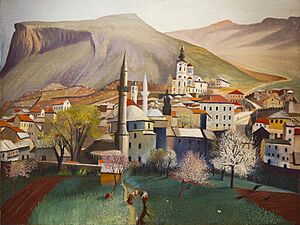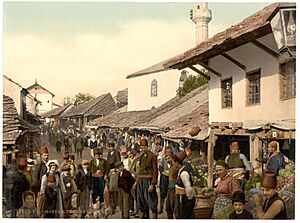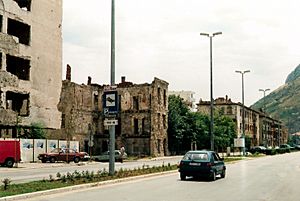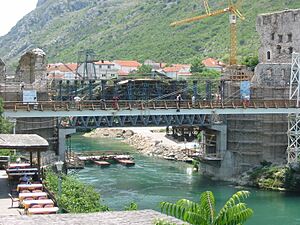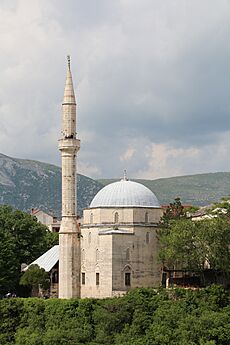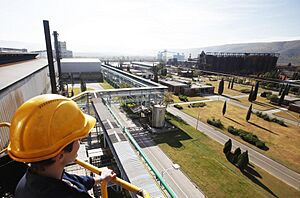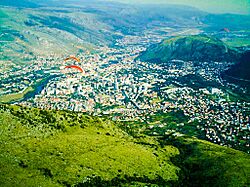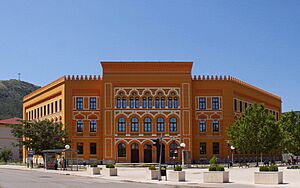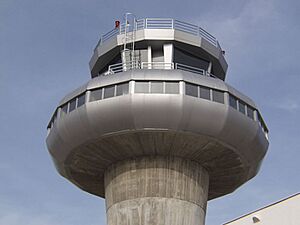Mostar facts for kids
Quick facts for kids
Mostar
Мостар
|
|||
|---|---|---|---|
| Grad Mostar Град Мостар City of Mostar |
|||
|
Stari Most with Mostar skyline
Peace Bell Tower
Pasha Mosque
Mostar bazar
Mostar Gymnasium
Mostar observation platform
|
|||
|
|||
| Etymology: Bosnian: mostar, lit. 'bridge keeper' | |||
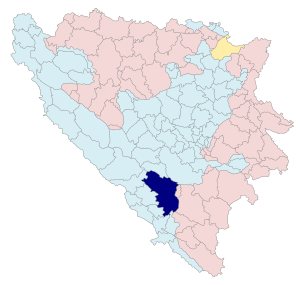
Map of Bosnia and Herzegovina (Mostar)
|
|||
| Country | |||
| Entity | Federation of Bosnia and Herzegovina | ||
| Canton | |||
| Geographical region | Herzegovina | ||
| Founded | 1452 | ||
| Area | |||
| • City | 1,165.63 km2 (450.05 sq mi) | ||
| Elevation | 60 m (200 ft) | ||
| Population | |||
| • City | 113,169 | ||
| • Density | 97.0883/km2 (251.4575/sq mi) | ||
| • Urban | 60,195 | ||
| Time zone | UTC+1 (CET) | ||
| • Summer (DST) | UTC+2 (CEST) | ||
| Area code(s) | +387 (0) 36 | ||
Mostar is a beautiful city in Bosnia and Herzegovina. It is the main city of the Herzegovina-Neretva Canton and the historic capital of Herzegovina. Mostar is located on the Neretva River and is the fifth-largest city in the country.
The city got its name from the "mostari," who were the bridge keepers. They guarded the famous Stari Most (Old Bridge) over the Neretva River a long time ago. The Old Bridge is a UNESCO World Heritage Site. It was built in the 16th century and is one of the most visited places in Bosnia and Herzegovina. People see it as a great example of Islamic architecture in the Balkans.
Contents
Mostar's History
Early Times and the Middle Ages
People have lived near the Neretva River for a very long time. We know this from old forts and cemeteries found there. Even the Romans lived in this area.
Not much is known about Mostar in the Middle Ages. The name Mostar was first used in a document from 1474. It referred to the "mostari" or bridge keepers. They looked after a wooden bridge used by traders and travelers. Mostar became an important trading spot between the Adriatic coast and central Bosnia.
The Ottoman Period
In 1468, the Ottoman Empire took control of the region. Mostar then started to grow into a city. It was called Köprühisar, meaning "fortress at the bridge." The city had two main parts: the čaršija for crafts and trade, and the mahala for homes.
The wooden bridge was rebuilt in stone in 1566. This new bridge, the Old Bridge, was ordered by Sultan Suleiman the Magnificent. It was about 28 meters long and 20 meters high. People thought it was amazing even back then. The Old Bridge was designed by Mimar Hayruddin. He was a student of the famous Ottoman architect Mimar Sinan. A traveler from the 17th century, Evliya Çelebi, said the bridge was "like a rainbow arch soaring up to the skies."
Austrian and Yugoslav Rule
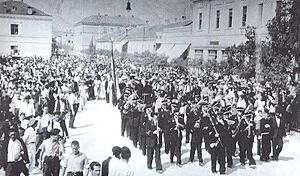
Austria-Hungary took over Bosnia and Herzegovina in 1878. They ruled until 1918, when Mostar became part of Yugoslavia. During this time, Mostar became the main city in Herzegovina. The city council worked with the Austro-Hungarian government to make big changes. They built wide roads and invested in new buildings and services. Famous buildings from this time include Hotel Neretva and the Gimnazija Mostar.
After World War II, Mostar grew a lot. It became a center for making plastics, tobacco, aluminum, and even aircraft. Many dams were built on the Neretva River to create electricity. Mostar was a big industrial and tourist city and did very well during the time of Socialist Federal Republic of Yugoslavia. The city's population grew from 18,000 to 100,000 between 1945 and 1980.
In the 1970s and 1980s, people started to care more about Mostar's old buildings. A plan was put in place to protect the old town. This brought many tourists and helped the city's economy. Mostar even won an award for this project in 1986.
The Bosnian War and Its Impact
After Bosnia and Herzegovina became independent in 1992, Mostar faced a difficult time. The city was attacked by the Yugoslav People's Army (JNA). Later, fighting broke out between different groups within the city. Mostar became divided, and many buildings were destroyed or badly damaged. This included churches, mosques, and most sadly, the historic Old Bridge.
About 2,000 people died in Mostar during the war. After the war ended in 1995, Mostar was left heavily damaged. The city was divided, with different groups living on different sides of the Neretva River.
Rebuilding Mostar
Since the war, Mostar has made great progress in rebuilding. More than 15 million dollars have been spent on fixing up the city. A huge project began in 1999 to rebuild the Old Bridge exactly as it was before. This project was finished in 2004. Many countries helped pay for this, including Spain, the United States, and Turkey. The bridge was officially reopened on July 23, 2004.
In 2005, UNESCO added the Old Bridge and its surrounding area to the World Heritage List. This means it's a very important place that should be protected for everyone. Efforts have also been made to help reunite the city after the war.
Mostar's Architecture
Mostar has many interesting buildings with different styles. You can see a mix of old and new, and influences from different cultures. For example, there are Italian-style churches, Ottoman houses, and Orthodox churches.
During the Ottoman rule, many mosques were built. These often included schools or markets. Sadly, many of the old mosques and churches were lost during the 20th century.
Most of the government buildings are from the Austro-Hungarian period. They have a grand, classical look. Many old Ottoman houses still stand, showing how people lived long ago. These houses often have an upper floor for living, a courtyard, and a veranda.
The oldest stone bridge in Mostar is the Kriva Cuprija ("Sloping Bridge"). It was built in 1558 as a test before building the bigger Old Bridge. The Old Bridge was finished in 1566. It is a single-arch stone bridge, a perfect copy of the original. It spans 28.7 meters over the Neretva River. The Halebija and Tara towers at each end of the Old Bridge used to house the bridge guardians.
The Cejvan Cehaj Mosque, built in 1552, is the oldest mosque in Mostar. Near it is the Old Bazaar, Kujundziluk. This market is named after the goldsmiths who used to work there. Today, you can find paintings and carvings of the Old Bridge and local symbols.
The Koski Mehmed Paša Mosque, built in 1617, is open to visitors. You can go inside and even climb the minaret for a great view. Nearby is the Tepa Market, which has been a busy marketplace since Ottoman times. It sells fresh local produce like figs, pomegranates, and honey.
Mostar's Culture
Mostar is a city rich in culture. The magazine Most and the Šantić Poetry Evenings are important for local artists and writers. "Dani Matice Hrvatske" is a big cultural event, often supported by the Croatian and Bosnian governments. "Mostar Summer" is another large event that includes poetry, music, and choir festivals. The city also hosts the "Melodije Mostara" (Mostar Melodies) music festival every year.
Mostar has many art places, including:
- Croatian Lodge "Herceg Stjepan Kosača"
- Cultural Center Mostar
- OKC Abrašević (Abrašević Youth Center)
- Pavarotti Music Centre
- Croatian National Theatre in Mostar
- National Theatre Mostar
- Museum of the Old Bridge
- Herzegovina Museum
- Mostar Youth Theatre
- Aluminij Gallery
- Birthplace of Svetozar Ćorović (Aleksa Šantić House)
- Muslibegović House
- World Music Centre
- Puppet Theatre Mostar
Mostar's food mixes Western and Eastern flavors. Traditional dishes are similar to Turkish and Middle Eastern foods. But because of Austrian influence, you can also find Central European dishes. Some popular foods include ćevapčići, burek, sarma, and musaka. For desserts, try baklava or tufahije.
Mostar's Economy
Mostar's economy mainly relies on the aluminium and metal industries. It also has strong banking and telecommunication services. Some of the country's biggest companies are based here.
Mostar is one of the largest financial centers in Bosnia and Herzegovina, along with Sarajevo and Banja Luka. One of the three biggest banks in the country has its main office in Mostar. Also, one of the three national electric companies, postal services, and telecommunication companies is located here. These companies, along with the aluminum factory, make up a big part of the city's economy.
Before the war, Mostar had other important companies that are now closed or much smaller. The Aluminij Industries company is still a major player. It is one of the country's largest exporters and works with many international partners. The city of Mostar gets a lot of money each year from Aluminij.
Mostar also has three dams that produce electricity. There are plans to use wind power and build windmills in the future. Many small and medium businesses have also started up, making the city's business environment better. Mostar also hosts an annual International Economic Fair Mostar, which started in 1997.
Mostar's Population
| Historical population | ||
|---|---|---|
| Year | Pop. | ±% p.a. |
| 1948 | 45,419 | — |
| 1953 | 40,559 | −2.24% |
| 1961 | 72,453 | +7.52% |
| 1971 | 89,580 | +2.14% |
| 1981 | 110,371 | +2.11% |
| 1991 | 126,628 | +1.38% |
| 2013 | 105,797 | −0.81% |
In 2013, the city of Mostar had a population of 60,195 people. The wider area of Mostar had a total population of 105,797.
Who Lives in Mostar?
Mostar's population includes different ethnic groups. In 2013, about 48.4% were Croats, 44.1% were Bosniaks, and 4.1% were Serbs. Mostar has the largest number of Croats in Bosnia and Herzegovina. The population mix changed a lot after the Bosnian War.
The ethnic makeup of Mostar over the years:
| Ethnic group | 1910 | 1931 | 1948 | 1961 | 1971 | 1981 | 1991 | 2013 |
|---|---|---|---|---|---|---|---|---|
| Bosniaks/Muslims | 7,212 | 8,844 | 9,981 | 10,513 | 33,645 | 34,247 | 43,856 | 46,752 |
| Croats | 4,307 | 5,764 | 6,062 | 27,265 | 32,782 | 36,927 | 43,037 | 51,216 |
| Serbs | 4,518 | 5.502 | 5,039 | 21,220 | 19,076 | 20,271 | 23,846 | 4,421 |
| Yugoslavs | 12,181 | 2,329 | 17,143 | 12,768 | 83 | |||
| Others | 355 | 185 | 332 | 1,274 | 1,748 | 1,789 | 3,121 | 3,408 |
| Total | 16,392 | 20,295 | 21,606 | 72,453 | 89,580 | 110,377 | 126,628 | 105,797 |
Towns and Neighborhoods
The City of Mostar also includes many smaller towns and neighborhoods, such as:
- Bačevići
- Banjdol
- Blagaj
- Bogodol
- Buna
- Cim
- Čule
- Dobrč
- Donja Drežnica
- Donji Jasenjani
- Dračevice
- Gnojnice
- Goranci
- Gornja Drežnica
- Gornje Gnojnice
- Gornji Jasenjani
- Gubavica
- Hodbina
- Humilišani
- Ilići
- Jasenica
- Kosor
- Kremenac
- Krivodol
- Kružanj
- Kutilivač
- Lakševine
- Malo Polje
- Miljkovići
- Ortiješ
- Pijesci
- Podgorani
- Podgorje
- Podvelež
- Polog
- Potoci
- Prigrađani
- Rabina
- Raška Gora
- Raštani
- Ravni
- Rodoč
- Selište
- Slipčići
- Sovići
- Sretnice
- Striževo
- Vihovići
- Vojno
- Vranjevići
- Vrapčići
- Vrdi
- Željuša
- Žitomislići
- Žulja
Some villages near Mostar, like Kamena, Kokorina, and Zijemlje, became part of a new area called Istočni Mostar (East Mostar) after the war.
Mostar's Climate
Mostar has a warm climate with hot, dry summers and cool, wet winters. In summer, temperatures can sometimes go above 40°C (104°F). The highest temperature ever recorded in Bosnia and Herzegovina was 46.2°C (115.2°F) in Mostar in 1901. January is the coldest month, averaging about 5.6°C (41°F), and July is the warmest, averaging about 25.8°C (78°F).
Mostar is the sunniest city in the country, with about 2291 hours of sunshine each year. Snow is rare and usually melts quickly.
| Climate data for Mostar (1981–2010, extremes 1949–present) | |||||||||||||
|---|---|---|---|---|---|---|---|---|---|---|---|---|---|
| Month | Jan | Feb | Mar | Apr | May | Jun | Jul | Aug | Sep | Oct | Nov | Dec | Year |
| Record high °C (°F) | 20.0 (68.0) |
25.0 (77.0) |
27.6 (81.7) |
31.5 (88.7) |
35.6 (96.1) |
41.2 (106.2) |
46.2 (115.2) |
43.1 (109.6) |
38.8 (101.8) |
32.5 (90.5) |
27.4 (81.3) |
19.8 (67.6) |
46.2 (115.2) |
| Mean daily maximum °C (°F) | 9.1 (48.4) |
11.1 (52.0) |
15.2 (59.4) |
19.5 (67.1) |
25.1 (77.2) |
28.9 (84.0) |
32.5 (90.5) |
32.7 (90.9) |
27.0 (80.6) |
21.3 (70.3) |
14.4 (57.9) |
9.8 (49.6) |
20.6 (69.0) |
| Daily mean °C (°F) | 5.6 (42.1) |
6.6 (43.9) |
10.1 (50.2) |
13.8 (56.8) |
19.0 (66.2) |
22.7 (72.9) |
25.8 (78.4) |
25.6 (78.1) |
20.5 (68.9) |
15.7 (60.3) |
10.2 (50.4) |
6.5 (43.7) |
15.2 (59.3) |
| Mean daily minimum °C (°F) | 2.4 (36.3) |
2.9 (37.2) |
5.7 (42.3) |
8.8 (47.8) |
13.2 (55.8) |
16.7 (62.1) |
19.5 (67.1) |
19.6 (67.3) |
15.4 (59.7) |
11.5 (52.7) |
6.8 (44.2) |
3.6 (38.5) |
10.5 (50.9) |
| Record low °C (°F) | −10.9 (12.4) |
−9.6 (14.7) |
−6.5 (20.3) |
−1.2 (29.8) |
3.3 (37.9) |
8.0 (46.4) |
8.4 (47.1) |
9.6 (49.3) |
6.4 (43.5) |
−0.1 (31.8) |
−4.8 (23.4) |
−7.8 (18.0) |
−10.9 (12.4) |
| Average precipitation mm (inches) | 139 (5.5) |
120 (4.7) |
127 (5.0) |
118 (4.6) |
90 (3.5) |
70 (2.8) |
43 (1.7) |
60 (2.4) |
122 (4.8) |
152 (6.0) |
185 (7.3) |
176 (6.9) |
1,402 (55.2) |
| Average precipitation days (≥ 1 mm) | 9.2 | 8.4 | 9.0 | 10.3 | 8.2 | 7.0 | 4.2 | 4.8 | 6.7 | 8.7 | 10.5 | 10.7 | 97.7 |
| Average snowy days (≥ 1.0 cm) | 2.9 | 1.5 | 0.6 | 0.0 | 0.0 | 0.0 | 0.0 | 0.0 | 0.0 | 0.0 | 0.1 | 1.2 | 6.3 |
| Average relative humidity (%) | 65.9 | 63.3 | 61.0 | 61.8 | 62.7 | 61.2 | 52.7 | 53.7 | 60.1 | 65.2 | 69.3 | 67.4 | 62.0 |
| Mean monthly sunshine hours | 125 | 129 | 164 | 180 | 240 | 271 | 328 | 306 | 226 | 174 | 120 | 111 | 2,374 |
| Source 1: NOAA | |||||||||||||
| Source 2: Meteorological Institute of Bosnia and Herzegovina, altervista.org | |||||||||||||
Mostar's Government
Mostar is a municipality with its own city government. The city is led by a mayor. Since February 15, 2021, the mayor has been Mario Kordić.
After the Bosnian War, there were efforts to reunite the city. A new plan for how the city would be run was put in place in 2004. This plan aimed to create one unified city government instead of several smaller ones. This helped to reduce duplicate services and costs.
However, there were still challenges in how elections were held. For several years, local elections could not take place in Mostar. This was because of disagreements over the rules. Finally, in July 2020, new laws were passed. This allowed local elections to happen in Mostar in December 2020.
Past Mayors of Mostar
| # | Portrait | Name | Term of Office | Party | |
|---|---|---|---|---|---|
| 1 | President Ismail and members Muhamed, Ahmed, Huršid, Javer, Jure, Ivan, Lazar | 1871 | 1878 | ||
| 2 | Muhamed-beg Alajbegović (Deputy: Blaško Zelenika) |
6 August 1878 | May 1890 | ||
| 3 | Ibrahim-beg Kapetanović | January 1890 | 6 January 1897 | ||
| 4 | Ahmet-beg Hadžiomerović | June 1897 | December 1907 | ||
| 5 | Mustafa Mujaga Komadina | 1909 | 2 November 1918 | ||
| 6 | Smail-aga Ćemalović | 1919 | 1929 | ||
| 7 | Ibrahim Fejić (Sub-mayors: Ljubo Krulj and Vlatko Tambić) |
1929 | 1934 | ||
| 8 | Muhamed Ridžanović | 1935 | 1935 | ||
| 9 | Husaga Ćišić | 1935 | 1940 | ||
| 10 | Husein Metiljević | 1940 | 1941 | ||
| 11 | Šefkija Balić | 1941 | 1941 | ||
| 12 | Muhamed Butum | 1941 | 1942 | ||
| 13 | Salih Efica "Crni" | 1942 | 1945 | ||
| 14 | Salko Fejić | 1945 | 1946 | ||
| 15 | Vilko Šnatinger | 1946 | 1947 | ||
| 16 | Manojlo Ćabak | 1947 | 1949 | ||
| 17 | Mustafa Sefo | 1949 | March 1958 | ||
| 18 | Vaso Gačić | August 1958 | October 1961 | ||
| 19 | Dušan Vukojević | October 1961 | February 1963 | ||
| 20 | Muhamed Mirica | November 1963 | May 1967 | ||
| 21 | Avdo Zvonić | May 1967 | May 1969 | ||
| 22 | Radmilo – Braca Andrić | May 1969 | May 1974 | ||
| 23 | Izet Brković | May 1974 | June 1976 | ||
| 24 | Dževad Derviškadić | June 1976 | April 1982 | ||
| 25 | Vlado Smoljan | April 1982 | July 1983 | ||
| 26 | Nikola Gašić | July 1983 | July 1985 | ||
| 27 | Damjan Rotim | July 1985 | April 1986 | ||
| 28 | Nijaz Topuzović "Toza" | April 1986 | April 1988 | ||
| 29 | Jovo Popara | 14 December 1988 | 14 December 1990 | ||
| 30 | Milivoj Gagro | 14 December 1990 | 1992 | HDZ BiH | |
| 31 | Mijo Brajković Safet Oručević |
1992 | 1996 | HDZ BiH SDA |
|
| 32 | Ivan Prskalo Deputy: Safet Oručević |
1996 | 2000 | HDZ BiH SDA |
|
| 33 | Neven Tomić Deputy: Hamdija Jahić |
2000 | December 2004 | HDZ BiH SDA |
|
| 34 | Ljubo Bešlić Deputy: Hamdija Jahić |
December 2004 | 18 December 2009 | HDZ BiH SDA |
|
| 35 | Ljubo Bešlić | 18 December 2009 | 15 February 2021 | HDZ BiH | |
| 36 | Mario Kordić | 15 February 2021 | Incumbent | HDZ BiH | |
Mostar's Education
Mostar has many schools and universities. There are two main universities: University of Mostar and University Džemal Bijedić of Mostar. The city also has nineteen high schools and twenty-four elementary schools.
Public schools in Mostar are divided into different groups based on their curriculum. This division started during the Bosnian War and still exists today. However, some schools, like Gimnazija Mostar, are trying to bring students together. They have shared administration and some joint classes.
The University of Mostar is the second-largest university in the country. It is the only university in Bosnia and Herzegovina where classes are taught in Croatian. It started in 1977. The University Džemal Bijedić of Mostar was founded in 1993. Both universities are working to improve and become more competitive.
As of 2015, the University of Mostar had over 10,712 students. More than 40,000 students have attended it since it started following the Bologna Process for education.
Mostar's Sports
One of the most popular sports in Mostar is football. The two biggest teams are HŠK Zrinjski and FK Velež. FK Velež won the Yugoslav Cup twice in the 1980s. After the Bosnian War, each club became supported by a different ethnic group. Matches between them are very exciting. HŠK Zrinjski has won the Premier League of Bosnia and Herzegovina eight times.
In basketball, HKK Zrinjski Mostar plays at the highest national level. The city also has a top handball team, Zrinjski. Many famous athletes come from Mostar, like Vahid Halilhodžić, a former football player and coach.
In 2011, a rugby union club called RK Herceg was started. They play in national and regional leagues.
Swimming is also popular in Mostar. There are three swimming teams: PK Velež, KVS Orka, and APK Zrinjski. The best swimmer from Bosnia and Herzegovina, Lana Pudar, is from Mostar. Mostar has many talented swimmers, even with limited swimming pools.
Mostar's Transport
Rail Travel
The city has the Mostar railway station. You can take trains from here to the capital city and also to Croatia.
Air Travel
Mostar is a popular place for tourists. The Mostar International Airport serves the city. There are also bus stations that connect Mostar to many places both inside and outside the country. The Old Town of Mostar is a major tourist spot, and the Stari Most is its most famous landmark.
Mostar's Tourist Attractions
Mostar has many interesting places to visit. These include the Bishop's Ordinariate building and the remains of an early Christian church at Cim. You can also see a hamam (an old public bath), a clock tower (sahat-kula), and the Synagogue from 1889.
Other important sites are the Nesuh-aga Vučjaković Mosque, Hadži-Kurt Mosque, and the Metropolitan's Palace. The Karagöz Bey Mosque (1557) and the Cathedral of the Holy Trinity (1873) are also worth seeing. Don't miss the old Ottoman houses, the Crooked Bridge, and the Tara and Halebija Towers.
The World War II Partisan Memorial Cemetery in Mostar is another important symbol of the city. It was designed by Bogdan Bogdanović. This monument combines nature and architecture beautifully. It was recognized as a National Monument in 2006.
Nearby places to visit include the Catholic pilgrimage site of Međugorje. You can also see the Tekija Dervish Monastery in Blagaj and the 13th-century town of Počitelj. Other attractions are the Blagaj Fortress, Kravica waterfall, and the seaside town of Neum. There's also the Roman villa rustica at Mogorjelo and Stolac with its ancient tombstones called stećaks. Nature lovers can visit the Hutovo Blato park, Lake Boračko, and the Vjetrenica cave, which is the largest cave in Bosnia and Herzegovina.
Notable People from Mostar
- Dušan Bajević, footballer
- Aleksa Šantić, poet
- Sergej Barbarez, footballer
- Bojan Bogdanović, basketball player
- Svetozar Ćorović, writer
- Vladimir Ćorović, historian
- Ivan Ćurković, footballer
- Dražen Dalipagić, basketball player, Olympic champion
- Dejan Damjanović, footballer
- Osman Đikić, poet
- Franjo Džidić, footballer
- Amina Kajtaz, swimmer
- Meho Kodro, footballer
- Zoran Mandlbaum, leader of the Jewish Community of Mostar
- Enver Marić, footballer
- Marino Marić, handball player
- Predrag Matvejević, writer
- Ćamila Mičijević, handball player
- Florijan Mićković, sculptor
- Gordan Mihić, playwright
- Ahmed Rushdi Mostari, poet
- Fevzi Mostari, writer
- Vlado Mrkić, writer and journalist
- Muhamed Mujić, footballer, Olympic medalist
- Dragi Sestic, music producer
- Saša Papac, footballer
- Boro Primorac, footballer
- Lana Pudar, swimmer
- Nino Raspudić, philosopher
- Ismet Rizvić, painter
- Dženan Salković, singer and songwriter
- Željko Samardžić, singer
- Aleksa Šantić, writer
- Marin Šego, handball player
- Blaž Slišković, footballer
- Arif Smajkic, medical researchers and academic
- Branka Sovrlić, singer
- Jasmin Spahić, retired Bosnian footballer
- Sergej Trifunović, actor
- Ornela Vištica, actress
- Franjo Vladić, footballer
- Hasan Ziyayi, poet
Twin Towns and Sister Cities
Mostar is connected with these cities around the world:
See also
 In Spanish: Mostar para niños
In Spanish: Mostar para niños











